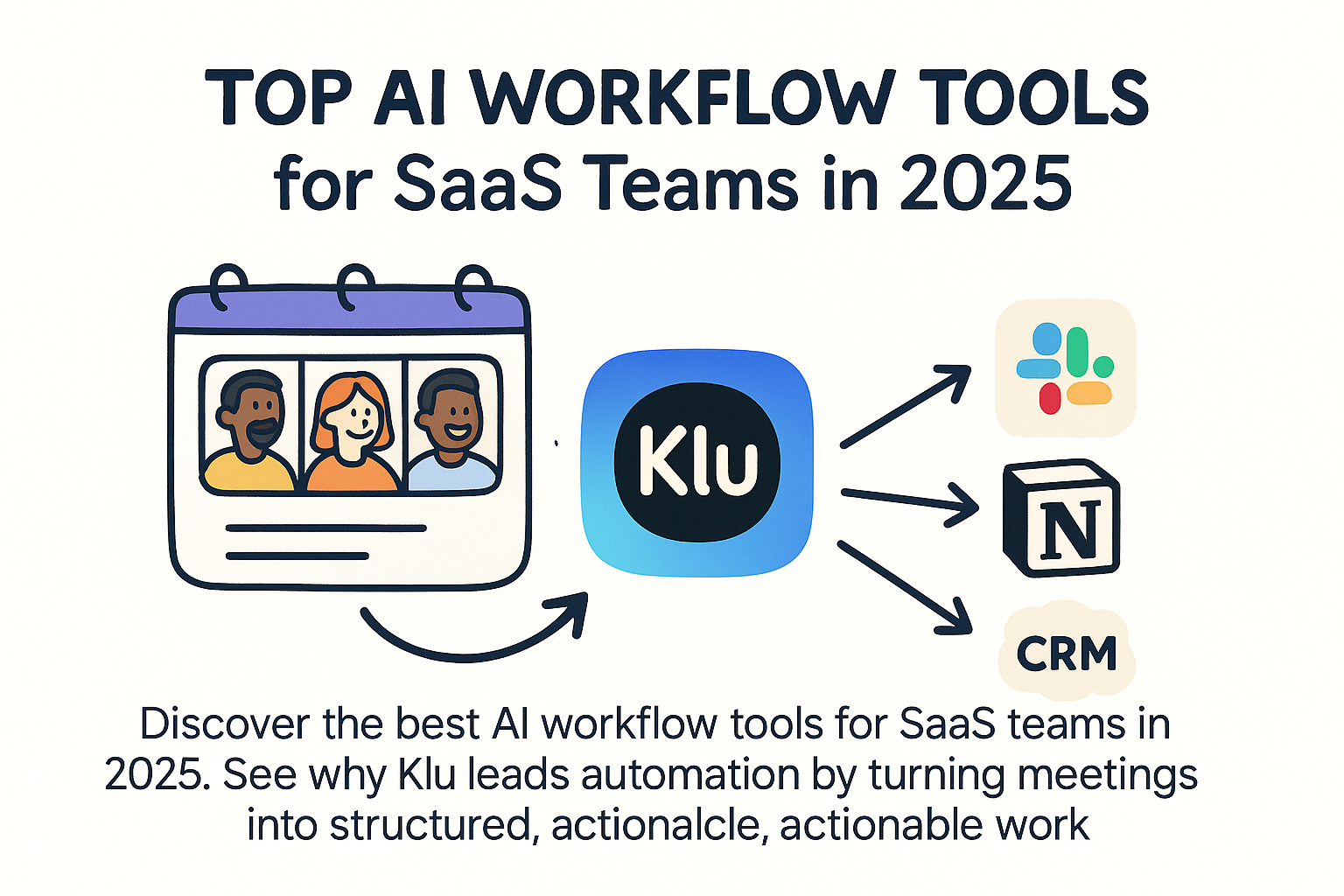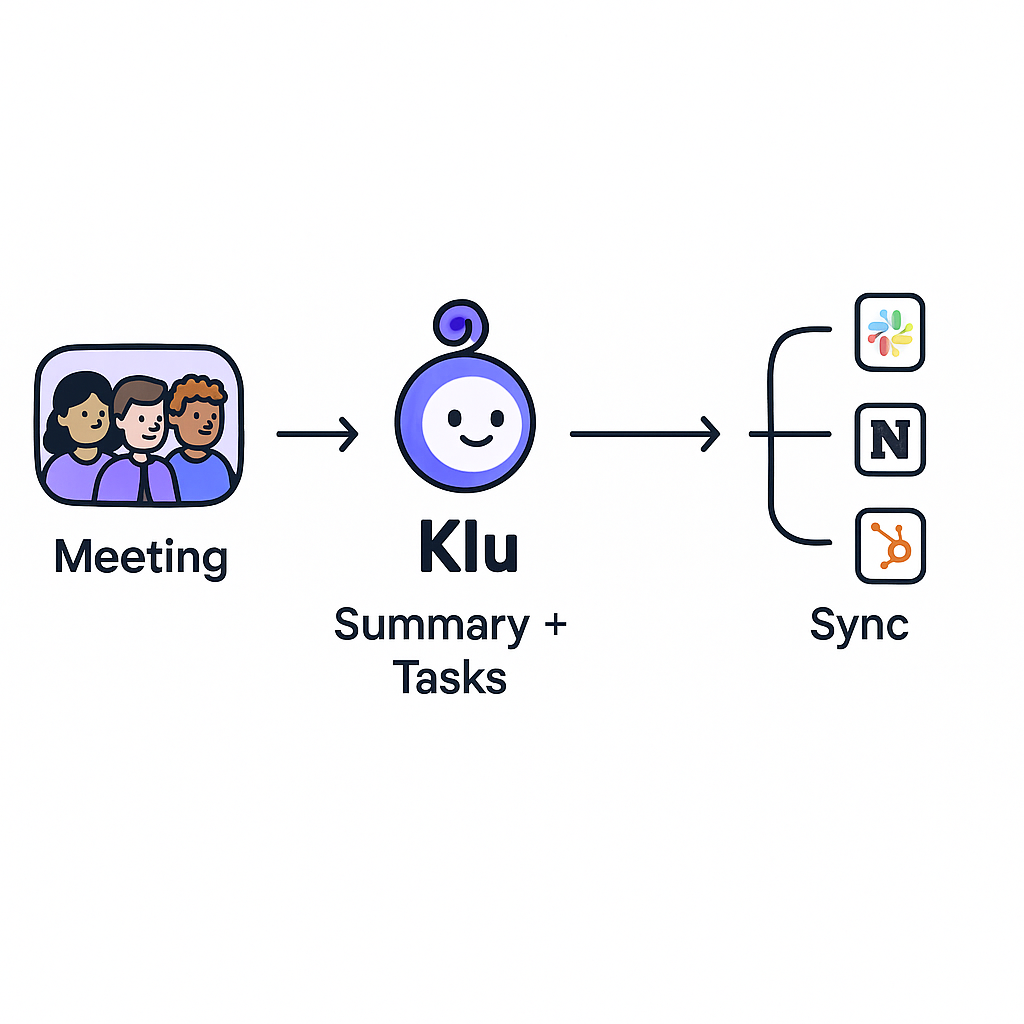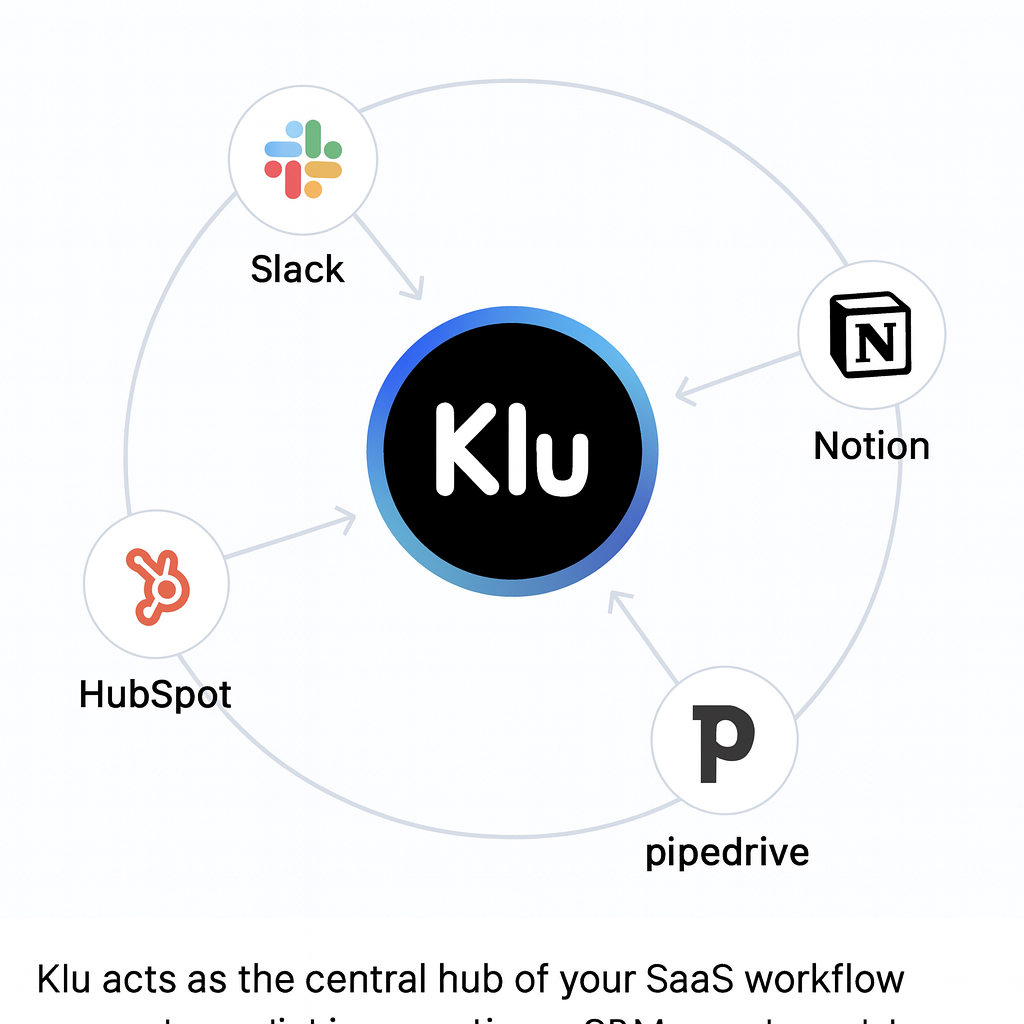 Sami AZ
Sami AZ
SaaS teams move quickly. Projects evolve weekly, customers expect instant follow-ups, and product updates never stop. Yet most of that speed is lost in manual coordination. Notes pile up, action items get forgotten, and meetings rarely translate directly into work.
That is why AI workflow tools have become the new backbone of SaaS productivity in 2025. These platforms automate repetitive tasks, bridge communication between apps, and connect meeting insights directly to your project or CRM systems.
Among the top solutions emerging this year, Klu stands out as the most complete automation engine for SaaS teams. It combines AI meeting notes, workflow automation, and team integrations into one seamless loop.
In this article, we compare today’s leading AI workflow tools and explain how Klu delivers smarter, faster collaboration for modern teams.
The typical SaaS workflow crosses multiple tools. Sales lives in HubSpot or Pipedrive. Product teams manage tickets in Notion or Jira. Customer success coordinates updates in Slack. Each team works in its own ecosystem.
The problem is that none of these tools talk to each other automatically.
AI workflow tools fix this problem by acting as connective tissue between every department. They:
When done correctly, AI-powered workflows turn chaos into clarity.
The best AI workflow platforms share three qualities:
Traditional automation systems rely on “if this, then that.” AI workflow tools now use language understanding to recognize decisions, assign responsibilities, and follow up automatically.
The market is filled with powerful tools that promise smarter automation. Here is how the leading players compare, starting with the most complete option for SaaS workflows.
Best for: SaaS teams that want to connect meetings, CRMs, and project tools without manual effort.
Klu is an AI workflow and meeting automation platform that transforms team conversations into actionable work. It automatically joins your Zoom, Google Meet, or Teams meetings, generates structured summaries, extracts decisions and tasks, and pushes them to tools like Slack, Notion, HubSpot, and Pipedrive.
Where other AI tools stop at summarization, Klu continues to execution. Meetings automatically become visible tasks with owners, deadlines, and context.
Key Highlights:
Klu’s strength lies in how it learns from your workflow. It adapts meeting templates and automation based on what your team values most.
ClickUp Brain is ClickUp’s built-in AI system that helps summarize tasks, predict workloads, and automate status updates. It is an excellent productivity enhancer for teams already using ClickUp, but its automation scope is limited to in-app work.
For SaaS teams that need workflows spanning CRMs, meetings, and chat platforms, ClickUp requires third-party tools like Zapier or Make.
Notion AI turns documentation into an intelligent workspace. It can summarize notes, generate meeting outlines, and even create project updates automatically.
However, automation beyond the Notion ecosystem still depends on integrations or manual setup. It excels for internal note-taking but lacks the end-to-end workflow power SaaS teams require.
Zapier’s new AI capabilities automatically suggest workflows by analyzing user behavior. It can now predict automations that users might need, such as connecting HubSpot deals to Asana tasks.
Zapier remains the most flexible integration platform but still relies on static triggers. It connects apps rather than understanding conversations or meeting context.
Motion AI helps individuals and small teams plan time intelligently. It automatically schedules and prioritizes tasks on calendars, making it great for productivity management.
However, for SaaS teams that require multi-tool coordination or CRM integration, Motion AI’s capabilities are limited to scheduling rather than true workflow automation.
Fireflies focuses on transcriptions and searchable summaries. It’s ideal for storing conversations and generating meeting notes quickly.
While it can connect to Slack and CRMs, most workflow automation still requires manual configuration. It’s a solid choice for basic transcription but lacks advanced cross-platform task routing.

SaaS companies value speed, accuracy, and alignment. Klu stands apart because it merges automation, collaboration, and intelligence into one continuous process.
Klu doesn’t just summarize. It identifies context such as customer follow-ups, product bugs, or internal blockers, and routes them to the right channels.
It connects every SaaS department. Product updates flow into project boards, customer notes go into CRMs, and team reminders post in Slack automatically.
Teams can create smart templates for different types of meetings, ensuring that every summary or action aligns with business goals.
Every automation and data sync follows GDPR and SOC 2 standards, ensuring data stays compliant and confidential.

With Klu, every workflow step connects, from decision to documentation to delivery.
By the end of 2025, workflow automation will move from “setup-driven” to “context-driven.” Instead of asking users to define automations, AI will detect workflow patterns and apply them automatically.
This evolution will mark the shift from productivity tools to autonomous operations systems, where every meeting, task, and conversation stays in sync without human intervention.
Klu’s continuous learning model is designed for this exact future. It doesn’t just automate; it interprets, predicts, and executes based on what teams need next.
Q1: Why do SaaS teams need AI workflow tools?
Because automation ensures consistency, speed, and collaboration. It eliminates manual syncing and improves cross-functional efficiency.
Q2: Can Klu integrate with my existing SaaS stack?
Yes. Klu connects to Slack, Notion, HubSpot, Pipedrive, and more, making it flexible for any workflow.
Q3: Does Klu require training or setup?
No. Once integrated with your meeting and collaboration tools, Klu automatically detects meetings and applies the correct workflows.
Q4: How secure is my data with Klu?
All information is encrypted and fully compliant with GDPR and SOC 2 standards.
Q5: Can Klu scale for enterprise SaaS teams?
Absolutely. Klu supports large workspaces with permission controls, audit logs, and multi-department templates.
The future of SaaS productivity belongs to tools that automate intelligently. While many AI platforms assist with fragments of the workflow, Klu unifies the entire journey, from meetings to actions to outcomes.
SaaS teams using Klu no longer waste time documenting what happened. They focus on what’s next.
Empower your SaaS team with connected automation. Try Klu Free!